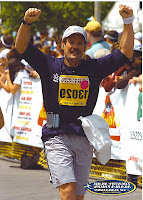“Today we are going to do a fartlek!” he babbled shaking uncontrollably from a caffeine blood level that would kill a moose. I paused, trying to comprehend through a haze of diet coke and Bagel Bites what in the heck he was talking about. Suppressing even my most vile middle school tendencies, I repeated what I had thought I had heard him say.
“A fart who?”
“ No, it’s not a who, it is a what. A fartlek. Speed play. Come on, any runner knows what a fartlek is.” I had to admit that if knowledge of distorted bathroom words was the singular qualification to be labeled a runner, I had failed miserably. There is no doubt that runners have a unique jargon, much like any obsession such as miniature car collecting and online war games, but obviously my education was seriously lacking. I had mastered VO2 max, lactate threshold, glycogen depletion, and carbo loading, but fartlek…no. Even writing it makes me giggle. Admit it. Try and say it three times in a row without laughing out loud. Any experienced runner can tell you there are times when, well, let’s say things emote unintended, yet I couldn’t imagine that they could build a whole workout around this unfortunate event.
Indeed fartlek is a legitimate term in the running lingo and it does mean speed play. It is Swedish (there’s the problem) and has been a mainstay of training for distance runners for years. Fartlek training was developed in the 1930s by Swedish coach Gösta Holmér (1891-1983) and has been adopted by many track aficionados since. It was designed for the downtrodden Swedish cross-country teams, which had been thrashed throughout the 1920s by Paavo Nurmi and the Finns. Holmér's plan used a faster-than-race pace and concentrated on both speed and endurance training I can only imagine that first day of practice for the hapless Swedes.
“Okee doakee Sven, today were going to fartlek past those fiendish Finns with explosive intensity!”
The idea is to use short bursts of speed to improve fitness and endurance. It also incorporates hills and rough terrain as it was originally designed for cross-country athletes. There is even a Fartlek Hill in Quantico, Virginia used by the Marine Corp to whip its officers into shape.
“Sound Off, One, Two Three, Four. I don’t know but I can see. Fartlek Hill makes a man out of me. Sound Off”
I do gravitate to the idea of speed play. We don’t often think of exercise and workouts as play, but I am convinced that the more we see this kind of activity as enjoyable and playful, the greater the benefits. There are not many studies about attitude and exercise, but I can tell you from my own experience that when I am running and just letting it flow, problems seem to melt away. I find that I look forward to my next run as I know I will feel better, look better, act better and avoid seeing Paris Hilton on TV for another day. If it is fun, your consistency and benefits skyrocket. Now it may be that you are just too tired to do anything else, but whatever works!
Speed play tricks the body into better fitness. It literally stresses the muscles and as they adapt, they strengthen. Our lives also sometimes need to be stressed for us to adapt and grow. It is hard to accept this in a culture where failure is equated with leprosy. I know personally that I learn the most from my failures. I don’t like this somewhat backward appearing logic. I would much rather learn voraciously from success after success, but the reality of my life is that successes often only follow failure. Rarely do they precede them. I don’t mean to imply that failure is to be embraced like a warm puppy on a frigid day. Fight it, avoid it, hate it, but understand that when it comes, and it will, learn from it.
After a strenuous fartlek session, my legs feel like rubber linguine, but I know all those little magic mitochondria are constructing new and stronger muscle cells like a Mexican building crew on a deadline. I will come back stronger from the stress.
We really don’t play enough. Years ago Robert Fulgham wrote a wonderful little tome in which he claimed that everything he needed to know in life he learned in kindergarten. I think he was right. One of those things was to play more. We are programmed to stop playing early in our upbringing, often at the bequest of a harried parent who just wants us to sit still and finish our summer reading book assignment. Some adults however never lose their lust for play. They are called adult attention deficit disorder patients! Seriously, if we all just played more and worried less we would live longer to have more time to devote to the important things in life like is the American Idol voting rigged and is Lindsay Lohan going to her fifth or sixth rehab? Play doesn’t have to be a pick up game of kick the can in the backyard, it is anything that actively engages the mind and the body and is intrinsically fun. Those of us who have kids understand the importance of play. We see it everyday.
Speaking of kids, if you ever want to completely embarrass your 10 year old daughter, proudly announce to her and her group of friends that you are going out for a short fartlek. Believe me, they will talk about that one for years.















